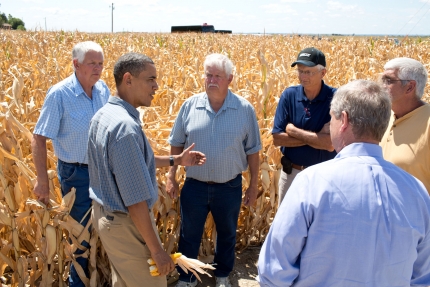Related Rural Blog Posts
USDA Drought Code Sprint: Giving Americans One-Click Access to Federal Drought Relief
Posted by on September 14, 2012 at 12:53 PM EDTEd. note: This is cross-posted from the United States Department of Agriculture Blog. Please note the deadline for submission has been extended to October 24.
Americans across the country are feeling the impact of the most severe and extensive drought in the last 25 years. We’ve heard from people throughout the United States, asking how they can help. That’s why today we’re launching USDA’s first-ever Drought Code Sprint, a call to developers across the country to use publicly available government information to help farmers, ranchers, and others gain quick and reliable “one-click” access to information on drought conditions and Federal drought relief. Developers can submit their apps using this form by October 24. Some of the most innovative ones will be featured on USDA.gov.
Crops are withering as a result of this historic drought and feed for livestock is growing ever more scarce and expensive. None of us is immune—these conditions are affecting over 50% of the country and almost 80% of our agricultural land. But our rural communities and family farmers and ranchers are on the front lines, and have been the first to feel the drought’s full effects. They are working hard to overcome these hardships, and the Federal Government has stepped up to help.
Of course, apps can’t influence the weather or refill our reservoirs. But they can help farmers and ranchers become more easily aware of the kinds of assistance available to them, and they can simplify the process of taking advantage of these options so relief gets to the people who need it as efficiently as possible.
Some tools we’d love to see include apps that provide “one-click” access to the nearest USDA service centers and available drought programs; county-level drought disaster designations and program eligibility; information on Federal assistance available based on location and sector; types of loans or refinance options available with a handy repayment calculator and eligibility requirements; drought maps; and localized weather outlooks. These are just a few of our ideas but we’re confident that you have even better ones—so get coding!
To get started, check out these publicly available data sets in the Natural Hazards Data Community on Safety.Data.gov and on the USDA drought website:
- USDA Service Center Locator
- USDA Secretarial County Disaster Designations
- Monthly Crop Production Reports
- Weekly Crop Progress and Condition Reports
- Hay Stocks
- National Integrated Drought Information System
- National Water and Climate Center data including SNOwpack TELemetry Network (SNOTEL) and Soil Climate Analysis Network (SCAN)
We encourage developers to use other freely available resources on safety.data.gov or the USDA website as well—including Agriculture Weather and Drought Outlook blog posts and Drought Assistance Programs and Information sites—and any other data resources that would be helpful to those affected by the drought.
Here is a great opportunity to apply American ingenuity and technology to the cause of helping America’s farms. We look forward to seeing your ideas.
Amanda Eamich is Director of Web Communications at the United States Department of Agriculture
Brian Forde is Senior Advisor to the U.S. Chief Technology Officer at the Office of Science and Technology Policy
Learn more about Energy and Environment, RuralGrand Opening of Dillon’s New Middle School
Posted by on September 12, 2012 at 4:02 PM EDTOn Thursday, September 6, 2012, I had the honor of celebrating the beginning of a new era in Dillon County, South Carolina as Dillon opened its newest middle school.
Three and a half years ago, Dillon’s school system was spotlighted when Ty’Sheoma Bethea wrote a letter to President Obama. Ty’Sheoma’s letter inspired the President and his Administration to help rebuild her school, and her letter reminded all Americans of what we can accomplish by working collectively toward common goals.
In 2010, this Administration awarded a $35.8 million loan and a $4 million grant to the Dillon County School Facilities Corporation to finance new construction and renovations for four schools in three districts in South Carolina. These United States Department of Agriculture funds were made possible by the American Reinvestment and Recovery Act, which has assisted communities like Dillon across America prepare for and invest in the future.
The new middle school replaces J.V. Martin Junior High School and is Dillon’s first new school in about 40 years. Ms. Bethea’s letter spoke to the President’s belief that a strong country only exists when we equip our children with a quality education, so they are prepared to win the future.
From the Archives: President Obama's 2011 Rural Tour
Posted by on August 15, 2012 at 3:22 PM EDT
A year ago today, President Obama kicked off a bus tour to meet with people throughout America's heartland for discussions about the economy. At townhalls in Minnesota, Iowa, and Illinois, the President discussed ways to strengthen the middle class and accelerate hiring in local communities and took questions on renewable energy, health care, and Social Security.
Check out a full recap here.
Watch the highlights of President Obama's rural economic tour in Minnesota here.
Watch the highlights of President Obama's rural economic tour in Iowa here.
Learn more about RuralIt Takes a County … to Help Feed Families!
Posted by on August 14, 2012 at 3:31 PM EDTUSDA employees at the Tipton Service Center in Iowa are making impressive contributions to this year’s Feds Feed Families campaign. USDA Rural Development employee Mike Boyle reported food donations exceeding 750 pounds for the month of June and 1,760 pounds in July – just a portion of what is expected to be distributed throughout Tipton and surrounding eastern Iowa communities as part of the food drive this summer.
“We’re off to a good start,” said Boyle. “Last season, we donated approximately five tons of food to local non-profits. Our goal now is to top that.”
What makes these efforts unique is that most of the food pledged comes from a local source, Tipton’s Hardacre Community Garden. Boyle and a small legion of volunteers donate their free time to grow fresh produce for neighbors in need. With hands in the dirt, these gardening enthusiasts cultivate a wide array of healthy fruits and vegetables. What’s grown is donated as part of the People’s Garden Initiative year-round ‘Share Your Harvest’ effort which directly supports the Feds Feed Families Food Drive.
The immediate recipients of the harvest are local individuals, churches, and nonprofit organizations such as the Cedar Manor nursing care center and the Bread of Life Food Pantry. These donations provide for those who may otherwise be unable to access fresh foods and help to build a healthy community food system.
More Help for Those Coping with the Drought
Posted by on August 13, 2012 at 7:08 PM EDTFarmers in Iowa are among those struggling with the fallout from the historic drought. Almost half of the corn crop is in poor or very poor condition. The same is true for more than a third of the soy bean crop. Disappointing yields are in turn driving up feed prices, and farmers and ranchers are having trouble feeding livestock. And there are similar stories throughout the nation's heartland.
Today President Obama saw the damage first-hand and described a new effort to help livestock producers.
Touring McIntosh Family Farms in Missouri Valley, Iowa, the President announced that the Department of Agriculture will begin to buy up to $170 million worth of pork, chicken, lamb, and catfish. And the President is directing the Department of Defense -- which purchased more than 150,000 million pounds of beef and pork in the last year alone -- to encourage its vendors to accelerate meat purchases for the military and freeze it for future use.
The goal is to give farmers and ranchers an opportunity to sell more of what they produce and save taxpayers money on food the government would have purchased for military bases, hospitals, schools, and food banks anyway.
"Understand this won't solve the problem. We can't make it rain," the President said. "But this will help families like the McIntoshes in states across the country, including here in Iowa. And we're going to keep doing what we can to help because that's what we do. We are Americans. We take care of each other."
To deliver more expansive aid for those hit by the drought, President Obama said that Congress needs to act.
"They need to pass a farm bill that not only helps farmers and ranchers respond to natural disasters, but also makes necessary reforms and gives them some long-term certainty," he said.
But in the meantime, the President won't wait for lawmakers to begin helping those struggling with the high temperatures and the lack of rain.
Learn more:
- The Department of Agriculture is collecting resources for farmers, ranchers, and small businesses wrestling with this crisis at USDA.gov/drought.
- President Obama discusses his administration's all-hands-on-deck approach to the drought in the Weekly Address.
- More information still is available at WhiteHouse.gov/drought.
Weekly Address All-Hands-On-Deck Response to the Drought
Posted by on August 11, 2012 at 5:30 AM EDTPresident Obama discusses the Administration’s all-hands-on-deck approach to one of the worst droughts in more than fifty years.
Transcript | Download mp4 | Download mp3
Learn more about Rural, Additional Issues
- &lsaquo previous
- …
- 4
- 5
- 6
- 7
- 8
- 9
- 10
- 11
- 12
- …
- next &rsaquo


